Dog Showmanship Guidelines
DOG SHOWMANSHIP
Acknowledgement: The information for this section is based on the University of Minnesota 4-H Dog Showmanship Guidelines.
The purpose of showmanship is for 4-H members to develop skills and knowledge in dog show handling. Showmanship allows 4-H members to learn about breeds of dogs and general grooming responsibilities.
Purpose of Showmanship Competition
Showmanship competition provides 4-H members with a meaningful experience where they can practice and improve their handling and sportsmanship skills. Showmanship gives each 4-H member the opportunity to present themselves and their dog to the best of their ability. This is exemplified by a handler working as a team with his or her dog, so the dog is stacked, alert, and under control, while at the same time the 4-H’er appears confident and in control. It is always important to remember that the 4-H showmanship ring is not the AKC showmanship ring.
- Showmanship will be evaluated on the following five basic areas:
- Proper breed presentation
- Ring procedure
- Knowledge
- Grooming of dog
- Youth’s appearance and conduct
Grooming of Dog
In showmanship dogs are required to be well-groomed. 4-H’ers are allowed assistance from a professional groomer but are strongly encouraged to learn these skills as they advance in experience. Excessive grooming of the dog in the ring to gain the judge’s attention will be considered a minor fault. Use of a brush or comb to reposition messy hair is acceptable but should be done very discreetly.
- Coat: The dog’s coat must be clean, not scaly, free of mats, and free of loose ha It is a major fault if a dog has mats or external parasites.
- Ears: The dog’s ears should be free of dirt, parasites, and excessive hai
- Eyes: The dog’s eyes should be clean and free of matte
- Toenails: The dog’s toenails should be trimm It is a major fault if the dog’s toenails are excessively long.
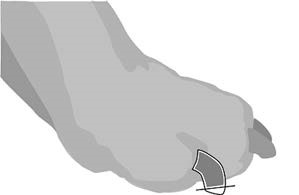 Toenail trimmed correctly.
Toenail trimmed correctly.
NOTE: Any dog with hair over its eyes that interferes with its vision may have the hair tied back with up to four rubber bands or plain, straight, rectangular-shaped barrettes that have a solid exterior color. No ribbons or bows are allowed.
Showing Dogs
Equipment:
Leads: There are several types of showmanship leads. They come in many styles, sizes, weights, and colors. Some include:
- Loop lead – this type has a loop at the end that slips over the dogs’ he Caution should be used when showing with this lead, so that it does not slip off the dog’s head.
- Martingale – this type has an additional loop at the end of the first loop and the dog’s head is placed between the two loo This allows the handler to have more control with the dog.
- Slip collar with a short leash/lead – this type is like those sometimes used in obedience but with a lead of four feet or less. The size of links should be appropriately matched to the size of the dog. It is appropriate for beginning and/or large and/or strong dogs to be shown with a slip collar. A showmanship lead is preferred, but no deduction shall be made for obedience leashes.
The size/weight of the lead should be appropriate for the size and/or breed of the
dog. Most large dogs should not be shown on lightweight leads.
Regardless of which lead is used, the handler must be in control of the dog and the
lead shall be held and used neatly. Deductions shall be made for leads hanging down
or flapping about the dog. The handler’s lead should be ready at all times and deductions
shall be made for time spent wrapping leads and getting ready to move out.
In the 4-H showmanship ring, the lead should never be removed when presenting the
dog to the judge.
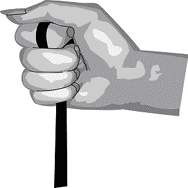 |
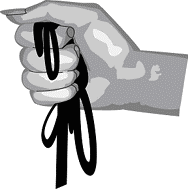 |
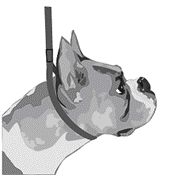 |
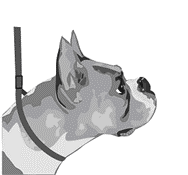 |
| Lead held correctly | Lead held incorrectly | Lead placed correctly on dog |
Lead place incorrectly on dog |
Bait: In the 4-H showmanship ring, baiting of dogs with food is allowed. If a 4-H’er uses bait, it must be used discretely, with no deliberate baiting near other dogs. If the bait is dropped in the ring and not immediately picked up OR is used to deliberately distract other dogs, the 4 H’er will automatically receive a white ribbon. Toys of any kind are not allowed in the showmanship ring.
The purpose of baiting is to animate your dog when stacking the dog in the lineup or during individual presentation to the judge. Your dog shows animation and/or expression by either wagging the tail or perking up the ears. Bait is also used to free stack your dog and keep his attention. (For a description of “stack” look under the heading titled “stacking”.)
- Baiting is to be done discreetly, without a lot of fanfare and fla Never stretch your arm out when holding the bait so that you are catching any other dog's attention. You need to be respectful of the other 4-H’ers in the ring.
- The size of the food bait pieces should be appropriate for the size of your dog. Semi-moist food chunks work best because they can be easily handled and quickly broken off without too much m Dry/hard bones or food cannot quickly be broken into smaller pieces. Bait should not be messy or gooey.
- Keep your bait in a bait bag or in your pants, or jacket pocket until you are ready to use it.
- Do not take the bait out of your pocket or bait bag until you are in the ring and the judge has placed you in the order he/she wants you to be i If you are free stacking your dog, you will need the bait to stack. If you are hand stacking your dog, you will not need the bait until after the dog has been stacked for animation, as the judge is looking the group over.
- Be sure to put the bait in your bait bag or pocket before gaiting around the ring in a g Never, ever leave the bait in your hand when not using it.
- Put your bait away in your bait bag or pocket right before the judge approaches for the individual examination of your dog.
- When you are doing an individual gaiting pattern, keep your bait in your pocket or bait bag. As you are completing the pattern and returning to the judge, you may take the bait out to present the dog to the judg
- Bait should be held directly in front of your dog. At what height/level to hold the bait depends on the size of the dog and experience of the handler. Again, you want to think of the overall picture you are creating for the judge.
- If you bait a big dog holding the bait too high, it will throw the balance of the dog totally off – big dogs have a habit of reaching for something high.
- If you bait a small dog too low, they do not respond.
- Never, ever throw the bait when you are in the showmanship ring. Never toss the bait in your hand, expecting to catch it while you are trying to get your dog’s attention. (You may not catch the bait.) This is just common courtesy and respect to other dogs and 4-H’ers in the ring.
Showing Procedure
Individual judges vary their judging routine and the following components may be mixed in any order.
GAITING
- Make your gaiting smooth, straight, and the correct spe When in motion, your dog should move naturally and freely. Avoid traveling ahead of or behind your dog.
- Always keep your show lead in the hand that is beside the dog. Do not keep the lead too tight or too loose for your breed or individual dog. The lead should never be so tight as to pull the dog’s feet off the ground.
- Avoid unnecessary motions or noises that detract from the gaiting procedu Use the entire ring unless the judge tells you to do otherwise.
- The dog is to be kept between the judge and 4-H’er at all tim It is a major fault if the 4-H’er is between the judge and the dog for a significant amount of time (examples: an entire side of the ring, entire pattern, all the way around the ring). It is a minor fault if the 4-H’er is between the judge and the dog for a minimal amount of time and the 4-H’er corrects the mistake.
GROUP GAITING
Normally, 4-H’ers will enter the ring in catalog order (numerical/armband order). Then the judge may choose to rearrange the dogs according to size and/or speed.
During group gaiting, the 4-H’er and dog will always move counter- clockwise around the ring. Under no circumstances may a judge direct the group to move clockwise around the ring. Gaiting is usually done around the perimeter of the ring with dogs on the left side of the handler. Passing should never be done except at the judge’s request.
It is important that handlers leave space between themselves and the dogs in front (for safety and to give the judge the best view of their dog). Crowding other dogs is a major fault.
During group gaiting, when the faster dogs are at the front of the line and “catch up” to the smaller dogs at the end of the line, it is appropriate for the 4-H’er to slow down the gait of his/her dog. The 4-H’er with the faster/larger dog should continue gaiting at a slower speed, even if it is not the proper speed for his/her breed.
INDIDIVUAL GAITING
During individual gaiting, the 4-H’er should move the dog at the correct speed for its breed. Depending on the breed, dogs will be shown at a walk, trot, or run, but the dog is always under control. The 4 H’er needs to move at a speed that will match the dog’s appropriate gait. Trotting is when one front leg and the opposite rear leg move forward at the same time. Under no circumstances, should a dog be shown at a pace. Pacing is when the legs on the same side of the dog move forward at the same time. Pacing is a major fault.
The youth may be asked to perform one or more of the following patterns.
Down and Back – The 4-H’er and dog will be asked to gait across the ring either on the diagonal or from end to end. At the opposite end of the ring, the 4 H’er has the option to do an about turn or to switch hands with the lead.
- If the 4 H’er does an about turn, the dog stays on the same side (left or right) and goes around the outside of the handler.
- If the 4-H’er switches hands with the lead, the 4 H’er and dog turn into/toward each other and proceed to the other end of the ring. The dog ends up on the opposite side of the 4-H’er from where it originally started (left to right or right to left).
NOTE: Executing a U-turn (where the 4-H’er goes around the dog) is a major fault.
"Triangle" Pattern – This pattern is performed in the shape of a right triangle. The 4-H’er and dog will proceed in a straight line away from the judge to the opposite end of the ring. At the corner make a left turn and proceed all the way to the next corner. Then one of three turns below may be made before proceeding up the diagonal and back to the judge. Under no circumstances may a judge direct a 4-H’er to do a reverse triangle where the 4-H’er would go down the diagonal first.
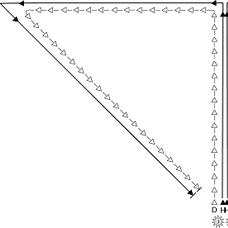 |
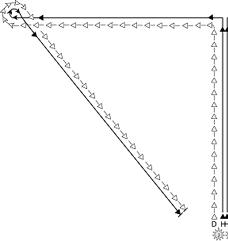 |
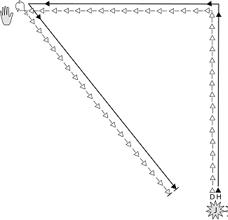 |
| Triangle with simple turn. The 4-H'er does not switch hands with the lead and the dog stays on the 4-H'ers left side. | Triangle with a circle at the corner. The dog stays on the 4-H’ers left side. The 4-H’er does not switch hands with the lead. | Triangle where 4-H’er switches hands with the lead and crosses the dog over in front of him/her. The dog completes a circle as the 4-H’er and dog turn into/toward each other and proceed up the diagonal with the dog on the 4-H’ers right side. |
“L" Pattern – This pattern is performed in the shape of an uppercase letter “L”. The 4-H’er and dog will proceed in a straight line away from the judge to the opposite end of the ring. At the corner make a left turn and proceed all the way to the next corner. The 4-H’er then switches hands with the lead. The 4-H’er and dog turn into/toward each other and proceed back to the other end of the ring. At this corner, the 4-H’er has three options:
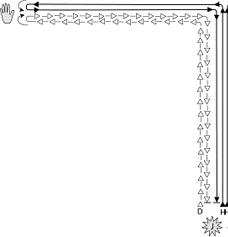 |
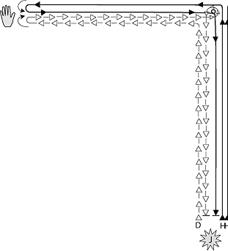 |
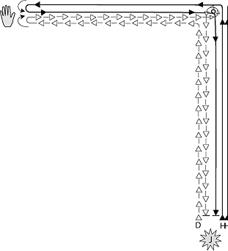 |
| The “L” pattern with a simple right turn. The 4-H’er does not switch hands with the lead and the dog stays on the 4-H’ers right side. | The “L” pattern with a circle in the corner with the dog always remaining on the 4-H’ers right side. The 4-H’er does not switch hands with the lead. | The “L” pattern where the 4-H’er switches hands with the lead and cross the dog over in front of him/her. The dog completes a circle as the 4-H’er and dog turn toward each other and proceed back to the judge with the dog on the 4-H’ers left side. |
“T” Pattern – This pattern is performed in the shape of an uppercase letter “T.” The judge will indicate where to start the “T” pattern. The 4-H’er and dog will proceed in a straight line away from the judge to the opposite end of the ring. The 4-H’er should turn to whichever side the dog is on and proceed to the corner of the ring. The 4-H’er then switches hands with the lead. The 4-H’er and dog turn into/toward each other and proceed to the other end of the ring. At the other end, the 4-H’er again switches hands with the lead. The 4-H’er and dog again turn into/toward each other and proceed back to the center of the ring. The 4-H’er then turns back toward the judge and proceeds in a straight line back to the judge.
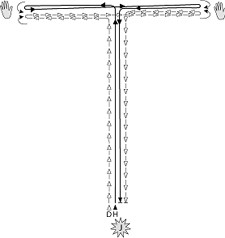
"T" Pattern
Courtesy Turn (used at the start of the individual gaiting pattern)-A courtesy turn is optional in 4-H but is recommended to get the dog moving from its stacked position. To do a courtesy turn, the 4-H’er will use a right hand turn before beginning the individual pattern designated by the judge. The courtesy turn should be executed quickly and smoothly and there should not be any break in the gaiting pattern. At this point it is acceptable for the 4-H’er to briefly pass between his/her dog and the judge.
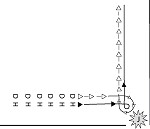
Courtesy Turn
As the courtesy turn is completed, the 4-H’er continues directly into the designated pattern (4-H’ers should not stop in between). If the courtesy turn cannot be executed smoothly, it should not be done because it then detracts from the overall teamwork.
SWITCHING HANDS
- It may be necessary in some patterns to switch the lead from one hand to the other to ensure the dog is always between the judge and the 4-H’er. These changes should be done gracefully at the corners of the patterns only as necessary to be sure the judge has an unobstructed view of the dog.
COMPLETION OF PATTERN
- It is customary for the 4-H’er to stop a few steps back from the judg Some judges will use a hand signal to designate when to stop, others may not. If a judge does not signal, be sure to stop two to three feet from the judge. Most breeds should stop and stand with all four feet square. The dog should walk into the stack squarely, without the 4-H’er moving the dog’s feet by hand. If 4-H’ers use their hands to stack their dog upon the completion of an individual pattern it is considered a major fault.
STACKING (posing with your dog)
- Stacking dogs should be done when the class stops gaiting around the ring. It should be maintained while the judge is doing individual examinations of other dogs in the class. The exception would be that occasionally the judge may give directions to relax your dog due to large class size, etc. This means that it is ok for the dog to sit or lie down; however, the 4-H’er must remain attentive to both the judge and his/her dog’s needs. (The 4-H’er may not relax.)
- 4-H’ers may lift from underneath the chest or mandible and hips to stack their dog.
- 4-H’ers shall never use the tail to stack their dog (as is done with some breeds in the AKC ring). It is considered a major fault to use the tail to stack a dog.
- 4-H’ers shall never lift all four feet of the dog off the floor at the same t It is considered a major fault to lift all four feet of the dog off the floor at the same time.
- Free stacking is walking your dog into the proper stack and keeping his attent The breeds that are stacked square are the easiest to work with and look the best free stacked.
- As the judge moves to various locations in the ring, it is important that the 4-H’er keep the dog between himself/herself and the judg The 4-H’er should not at any time block the view of the dog from the judge (hands on tail, hands over muzzle, etc.). It is acceptable for the 4-H’er to stack his/her dog by reaching over the dog to position the feet furthest from him/her.
- For safety reasons, under no circumstances may a judge walk between the ring gating and the “line up” of 4-H’er If a judge wants to observe the group switching sides, they should move the “line up” to the diagonal.
- It is each 4-H’ers responsibility to find out how their breed is customarily stacked. While stacking the dog, handlers will be evaluated on the correct stack for the bree All breeds are stacked with their front feet positioned evenly with each other.
- It is each 4-H’ers responsibility to leave sufficient space between them and the dog in front of them. Sufficient space means there is enough room for the judge to walk between the dogs without touching either dog or feeling crowded.
- 4-H’ers should work to develop proficiency in speed and ease of stacking. To begin learning this process, 4-H’ers should begin practicing walking their dog into a stack where the dog will automatically place its front feet squarely.
- The judge may request that 4-H’ers move to a different location in the ring or restack their dog facing another direc When this occurs, it is important to be able to turn the dog gracefully and to re-stack the dog quickly.
INDIVIDUAL EXAMINATION OF THE DOG
Individual examinations of each dog will be conducted, usually from the group stack. The judge may look at the dog from a few steps back and then move forward to examine the dog. While the judge is doing this, the 4-H’er should be attentive to the judge while maintaining full control over the dog.
Some judges may ask the 4-H’er to show the bite (teeth) of the dog at this time. The 4-H’er should show the front teeth for all breeds. The purpose of showing the bite in the 4-H ring is to check for cleanliness. 4-H’ers whose breed would typically require showing side teeth in the AKC ring are not required to do so in the 4-H ring. The 4-H’er should pull the dog’s lips back so the judge has a clear view of the dog’s front teeth with the dog’s mouth closed. 4-H’ers should be careful not to get hands or head in the way of the judge’s view of the bite.
General Showmanship Guidelines:
- As the judge moves, the 4-H’er should move around the dog, so the dog stays between the handler and the judge, while keeping the dog under control.
- Refer to all other General Showmanship Guidelines on pages 1-3 and your county or show rules.
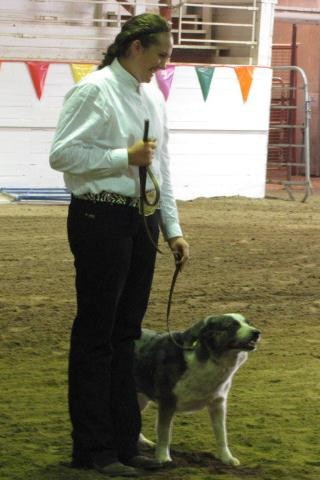 Exhibitor with dog on lease.
Exhibitor with dog on lease.
